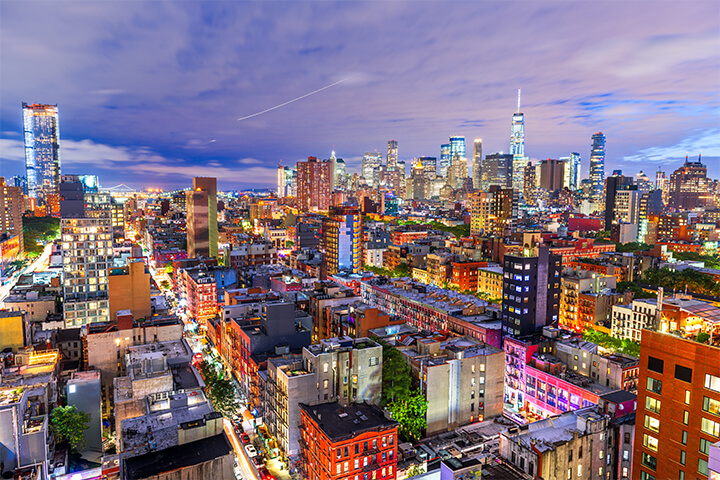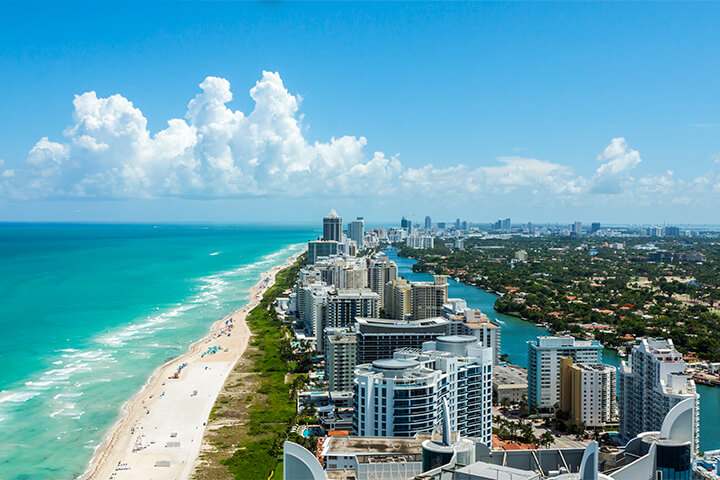Certain cities in the United States offer plenty of risk and reward for restaurant owners and operators. Read on as we present the top five most competitive culinary landscapes in the United States. Within these cities, contenders face off against a dense network of established players, all vying for success.
1. New York City

The Big Apple remains king for the sheer fact that every cuisine imaginable finds a home there. However, securing a prime location comes at a premium.
The consensus from restaurant owners reflects this paradigm. With a diverse audience open to anything, the NYC area is a dream come true for restaurateurs and chefs. But to survive the real estate market, you’ll need a watertight business plan and a little touch of insanity.
Rent prices in prime Manhattan locations are ungodly expensive, while city regulations and an overwhelming rat population add another layer of complexity. However, the sheer volume of foot traffic — over 60 million tourists annually and a massive population of hungry locals — make the risk worth it. Luckily, populous outer boroughs like Brooklyn and Queens are less expensive, and people are willing to make the pilgrimage out of Manhattan for their favorite flavors.
How NYC Restaurants Are Staying Afloat
According to TouchBistro’s 2024 State of Restaurants Report, rising food costs served as the greatest financial strain for restaurant owners this year. However, there are several new trends that New York City restaurant owners have embarked upon in 2024 to combat financial loss:
- Many restaurants have added catering to the menu;
- There has been a boost in non-alcoholic drinks sales;
- And nearly a third of all restaurants have turned to Tik Tok to reach younger patrons, adding to their already immense social media presence.
Some turned to simpler tactics, for instance, doing the shopping themselves to forgo the extra service fees of a middle man and delivery cost.
Beyond serving the best pizza in the world, there have been recent explosions in the Korean barbecue sector, Oaxacan cuisine, and West African fine dining. The city’s vibrant food culture, coupled with its reputation for innovation, continues to make NYC a magnet for talented chefs and food entrepreneurs who serve the best in world-class cuisine.
2. Los Angeles

The City of Angels offers a vibrant, sun-soaked counterpoint to NYC’s frenetic energy. While real estate is still very expensive, there’s a wider range of options compared to the densely packed East Coast metropolis.
LA’s year-round sunny climate has made food trucks ubiquitous throughout the city. They offer flexibility and a lower barrier to entry, making businesses possible in a city with such high operating costs. The city’s sprawl allows for more affordable options outside the West Hollywood and Venice Beach core, offering its young and adventurous population plenty of off-the-beaten-path gems.
Beyond sprouted avocado toast, LA’s outstanding culinary scene reflects its diverse population — Korean fusion, Michelin-starred Omakase experiences, and high-end vegan restaurants all thrive. The average Angeleno also values health and wellness, fueling farm-to-table establishments and innovative plant-based concepts. Moreso, LA is a taco-lover’s dream.
Find Every Taco Under the Sun in LA
As the undisputed taco capital of the US (sorry Texas) Mexican cuisine enthusiasts can dine on authentic tacos from a different region — such as Oaxaca, Guerrero, Veracruz, Tijuana, Mexico City, and Guadalajara — every day of the week. The hunt for the latest and greatest taquerias and food trucks around the city is a legitimate past time, thanks to LA’s industrious and talented Mexican population.
Despite being a booming culinary scene full of healthy and fresh dishes that don’t fall short on flavor, LA is a tough market. Rent, labor costs, and ingredient prices are among the highest in the country. Restaurants are also constantly competing with local celebrity chefs and up-and-coming trends.
To maintain profit margins, about 45% of operators have shopped around for less expensive suppliers and added more off-premise ordering options. Others credit their success to loyalty programs, with Angelenos boasting the highest rates of program engagement in the US.
3. Miami

Miami is a tropical haven for food lovers, with a stronger focus on Latin American and Caribbean cuisine than most large cities. World-class Cuban cafes compete with trendy Venezuelan arepa stands, which compete with Colombian comfort food, which compete with the bold flavors in Little Haiti, and so on. Competition may be fierce, but the city’s growth and international appeal offer locals and visitors endless possibilities.
To succeed in Miami’s most lucrative spots, the market demands a flawlessly executed, alluring concept. There’s a high cost of living and intense competition for pricey real estate in spots with a constant influx of tourists and areas that host a vibrant nightlife. While these factors make it a challenging market for restaurateurs, it hasn’t deterred growth.
Miami has seen a surge in other international cuisine like Japanese, Italian, and French and hosts a burgeoning craft brew scene. For celebrity chefs, expanding their empire into Miami is now a must. Big names like Massimo Bottura, Tom Colicchio, and David Chang have all set up shop in Miami within the last few years.
Miami’s Food Is as Hot as the Weather
Luckily, real estate is more affordable off-the-beaten path. Outside of the crowds, you’ll find truly authentic offerings that keep customers coming back. Neighborhoods like Little Havana, Coconut Grove, Allapattah, and Hialeah offer creative dining that is more intimate and more affordable than locations like South Beach. These neighborhoods have a strong sense of community, which locals and adventurous tourists value as part of the experience.
Thanks to Miami’s endless blue skies of summer, tourism is always bustling. The biggest problem for restaurateurs now, reflects the nationwide trend of increasing food prices which has prompted restaurants to raise their prices. The difference in Miami however is only around 5%, which patrons have accepted without a fight.
Miami’s restaurant industry also leans heavily on Instagram to attract guests, much more than NYC or even LA. As a popular destination for influencers and celebrities, restaurants often collaborate with people in the spotlight to promote their establishments. It doesn’t hurt that Miami’s sun, surf, and sand backdrops are always Insta-ready.
4. Chicago

As the Midwest’s most competitive food city, Chicago has always been a battleground for aspiring restaurateurs. The competition in 2023 and 2024 has been particularly fierce, with a surge in new openings in an ever-evolving industry.
Chicago’s creative spirit has resulted in a thriving fine-dining market, with Michelin-starred restaurants like Alinea, Grace, and Ever serving as beacons of excellence. While Chicago’s upscale options are impressive, it is the international dining scene that truly captures the heart of the city.
Residents are spoiled for choice when looking for authentic fare. In the mood for moussaka? Head to Greektown. On the hunt for the perfect pierogi? You’ll find it in the Ukrainian Village. Want to test your spice tolerance with some Indian food? Devon Avenue is dedicated to just that. Diners can feast on Mexican in the historic Pilsen neighborhood, go on a dim sum tour in Chinatown, carbo-load in Little Italy, or find perfectly spiced sausage in Germantown, just for starters.
Chicago’s High-Rent Hustle
One of the most significant challenges Chicago restaurateurs are facing is the skyrocketing cost of real estate. As US News reported earlier this year, Chicago is now considered one of the most expensive cities in the US. Prime locations in neighborhoods like West Loop, River North, Lincoln Park, Bucktown, and Fulton Market have become increasingly expensive, making it difficult for independent operators to secure a foothold. As a result, many restaurateurs are turning to less traditional neighborhoods or exploring shared kitchen spaces to reduce overhead costs.
Despite these challenges, Chicago restaurants remain optimistic about the future, with many planning expansions and adding new services.
5. San Francisco

San Francisco is an exciting place for restaurateurs and chefs. Their diners tend to be incredibly educated about food, while the city itself fuels a progressive and experimental culture.
San Francisco’s food scene is known for its emphasis on fresh, locally sourced ingredients and sustainable practices. It has also been a veritable haven for vegan, vegetarian, and eco-conscious diners for decades. Now, as the rest of the country warms up to San Francisco’s food philosophies, the city has experienced a rise in food tourism. The city’s proximity to the Pacific Ocean and its wine-producing regions have also influenced its food scene, with a focus on seafood and wine pairings.
San Francisco’s culinary scene is also a study in global influences with a local twist. The city is full of addictive Asian flavors, with Michelin-starred dim sum palaces in Chinatown to hidden gem Vietnamese, Japanese, Korean, and Filipino options at the ready. There’s also a wealth of African restaurants, for instance, authentic Ethiopian, Somali and Liberian cuisine that keeps newbies returning for more. Locals and visitors can also find authentic Mexican flavors and the burrito of their dreams in the Mission District.
San Francisco’s Early Bird Special
One issue restaurateurs find challenging is that San Franciscan diners eat dinner earlier than other major food cities with a median final seating of 9pm. Some restaurant owners extend their hours during peak tourism time, so as not to infuriate European travelers used to a very different nightlife.
San Francisco’s real estate market presents another challenge. The tech boom brought along sky-high rents and a high cost of living, which means labor costs are high. San Francisco also has a complex regulatory environment, with strict health and safety codes, permitting requirements, and wage laws. Navigating these regulations can be time-consuming and costly, often requiring significant administrative resources and far more paperwork than less competitive cities.
Despite these challenges, innovative and crafty restaurant management keeps this foodie paradise bustling for all to enjoy. San Francisco’s culinary scene welcomes dreamers and doers who wish to express themselves and create something truly special, making the competition worth the risk.
Culinary Gladiators
When you operate in NYC, LA, Miami, Chicago, and San Francisco, expect sky-high rents, a war for top talent, and the constant need to innovate or fade into obscurity. But for those who thrive under pressure, these cities offer immense opportunity and well-earned rewards. What’s your favorite food city? Let us know in the comment section!



